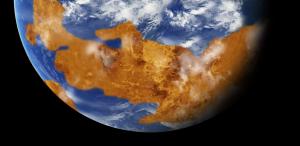Blog
Seas of Venus
22 September 2019
 NASA
NASAThree worlds there are, terrestrial in size, so similar and yet so different. Venus, Earth and Mars share a cosmic Goldilocks relationship. Mars, most distant of the three is cold and dry. Earth is just right, rich in life and moderate temperatures. Venus, closest to the Sun, is hot and arid.
It’s easy to imagine that the characters of these worlds is purely a matter of distance from the Sun. The closer you are, the hotter things get, and so only Earth is “just right” in its distance. But things are not so simple. All three were once worlds rich in water and moderate temperatures. Since Mars is the smallest of the three, lacking any strong magnetic field, it’s once vast oceans evaporated and froze. We see the evidence of its wet period in its geology.
Earth’s greater mass and stronger magnetic fields meant that it could hold its water long enough for diverse life to arise. It also had a “snowball” period which nearly wiped life from its surface, but through geological activity and other processes found a long-term balance point where life could thrive.
But what of Venus? We know the planet had a water-rich youth. It’s thought that Venus was we for the first few hundred million years at least, but lacking a magnetic field it gradually lost its water due to a higher temperature and solar winds. But new research suggests the wet period of Venus could have been longer. Much longer.
Michael Way and June Wang recently modeled the atmosphere of Venus across its history.1 Their model included the terrain of Venus and assumptions about the amount of surface water in its youth. Their model also included the gradual increase of solar radiation over geologic time as the Sun has gradually warmed. What they found was that in a range of models ranging from a Venus with shallow seas to an ocean-world Venus, the transfer of heat between land, sea and air could have maintained moderate, Earth-like temperatures for 2-3 billion years. This would mean that Venus could have been much like Earth until about 700 million years ago, when a massive change in geologic activity outgassed vast amounts carbon dioxide into its atmosphere, transforming it into the deadly hot planet we see today.
What’s interesting about this idea is that 700 million years ago Earth was rich with multicellular life. In another 100 million years or so the Cambrian explosion would occur leading to the complex life all around us. We have fossils on Earth that are 700 million years old. If life did arise on Venus, perhaps there is a fossil record.
It is important to note that while the work does show Venus could have had a long temperate period, that doesn’t mean that it did. We’d need geological evidence to confirm the model. But perhaps a young Venus, not Earth, was our solar system’s first Eden.
Way, Michael J., and June Wang. “Venus Topography and Boundary Conditions in 3D General Circulation Modeling.” Planetary Cartography and GIS. Springer, Cham, 2019. 325-335. ↩︎